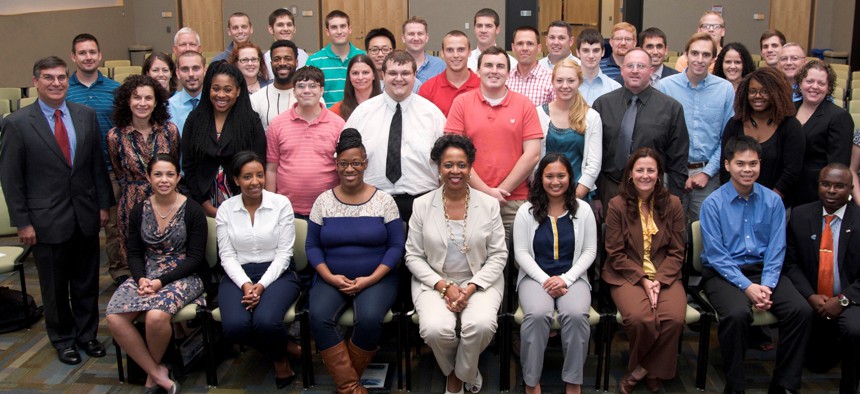
U.S. Navy photo
A Realistic Path to Modernizing the Civil Service
Ten considerations for updating and improving government operations.
The 2020 presidential candidates are proposing a host of new ideas about the role and scope of the federal government. While Americans will have to grapple with these proposals in the coming months, an important issue is not being discussed: whether the federal government is capable of fulfilling its core responsibilities and helping the president implement the laws that the voters entrusted to him or her.
Without focusing on the existing capacity of the federal government to do its job, all of the presidential candidates’ policies and programs risk failure.
That is why we partnered to host a series of Civil Service Modernization Dialogues, inviting people from a range of organizations to think deeply about the causes of the government’s current dysfunction and what its cures might be. The result is what we are calling the 10 Considerations for Civil Service Modernization.
The 10 Considerations are based on a simple concept: defining the general approaches that most, if not all, stakeholders in the civil service modernization debate could coalesce around. We hope that our findings help the presidential candidates, Congress and the administration develop legislation and policies for a modernized civil service that is accountable, trustworthy, professional and equipped with the tools and resources required to meet our enormous national challenges.
The federal government employs 2.6 million civil servants, with a $4.4 trillion budget, touching Americans’ lives on a daily basis. But federal employees are mired in 19th and 20th century rules, regulations, business processes and technologies that greatly inhibit their ability to do their jobs. It takes months to do a simple hiring action or procure everyday products and services when in the private sector hiring can be done in a day and Amazon ships products the same day they’re ordered. And those are just the surface symptoms.
There are alarm bells ringing everywhere that the civil service is in deep distress. Future generations are shunning federal service—just 6% of the current workforce is under the age of 30—because they can find better employment at places that aren’t so bogged down in antiquated practices. The current workforce is forced to rely on archaic IT systems that are vulnerable to malicious cyberattacks and data systems that were state of the art when Apple introduced the Mac.
In an era when all other aspects of American life are being transformed by technological and economic innovation, public administration of the executive branch seems frozen in time.
It’s time to modernize our federal government—both in terms of the tools available to federal agencies to carry out the policies of elected leaders, and the methods available to agency leaders to manage the federal workforce.
The path to sustaining a professional and modern civil service is to challenge and encourage civil servants to do their best to accomplish the people’s will, incentivize creative and outstanding administration of taxpayer dollars, hold employees properly accountable when they fall short and equip them with the tools and resources they need to do their jobs.
This seems like a simple formula, but the current civil service modernization debate is deeply polarized. Entrenched interest groups fear losing something important to their stakeholders, whether it is jobs, funding or influence.
The 10 Considerations could break that logjam by focusing on three broad changes that benefit all stakeholders:
- Streamlining processes and promoting a cultural shift that enhances accountability in the workforce, including training supervisors to incentivize high performers and ensuring that poor performance is appropriately addressed.
- Simplifying administrative and regulatory processes that hinder the effective and efficient functioning of government, such as hiring and procurement processes.
- Reskilling and retraining the civil service workforce to ensure that federal employees have the resources and knowledge they require to effectively deliver mission results to the American taxpayer.
Ultimately, civil service modernization will be possible only if civil servants and the society they serve both bear burdens and see benefits. All-or-nothing approaches rooted in toxic political discourse will produce precisely nothing.
We should emulate President George H.W. Bush, who in his first days in office in 1989 took care to celebrate the “values of a professional civil service whose highest principle is one of patriotism, whose foremost commitment is to excellence, whose experience and expertise is in itself a national resource to be used and respected.”
Bill Valdez is president of the Senior Executives Association. Adam White is a resident scholar at the American Enterprise Institute.






